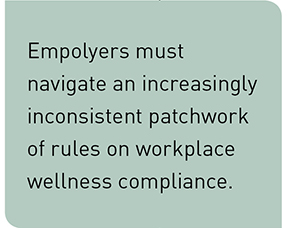HOME | ABOUT US | MEDIA KIT | CONTACT US | INQUIRE
HOME | ABOUT US | MEDIA KIT | CONTACT US | INQUIRE

 */?>
*/?>
Workplace wellness programs remain on the rise. More employers than ever are using the programs to identify, evaluate and treat health risks posed by employees, and in some cases to incentivize lifestyle changes to promote improved wellbeing and productivity.
Federal policy seems to support these efforts but, as is often the case in Washington, D.C., different agencies serving different interests view the landscape differently. Perhaps nowhere is this collision of competing views more pronounced than in the way federal rule-makers regulate workplace-wellness programs. It’s unfortunate because employers, to provide even the most basic form of wellness program, must navigate an increasingly patchworked and inconsistent array of rules, leaving them vexed and frustrated.
To illustrate, consider how competing federal agencies regulate the most prevalent wellness program, the simple health risk assessment, or HRA. HRAs can be as basic as asking employees to complete a health questionnaire, but can be (and often are) more detailed, involving a biometric screening to identify latent or chronic conditions affecting employees.
Some wellness programs—those offering incentives for certain health outcomes, such as weight, blood pressure and cholesterol within health ranges—are substantially regulated by the federal HIPAA law and the Affordable Care Act. The HIPAA/ACA rules, crafted by the IRS and the Departments of Labor and Health and Human Services, impose limits on incentives, require employers to offer alternatives for earning incentives, and add modest notice obligations.

But those agencies leave HRAs and other participation-based programs—that is, programs where the incentives are available merely for participating—largely unregulated. For example, an employer may condition enrollment in a health plan on an employee’s participation in an HRA, or may charge the non-participating employee an almost unlimited amount more for the insurance (in reality, most incentives are modest).
Enter the Equal Employment Opportunity Commission. The EEOC enforces the Americans with Disabilities Act and the Genetic Information Nondiscrimination Act (GINA). Both laws impact wellness programs.
The ADA bars most post-employment medical examinations and inquiries that might reveal a disability. A typical HRA involves just these sorts of inquiries and exams. GINA prohibits employers from asking an employee for family medical history as part of a health plan’s enrollment process, or asking for it later (e.g., as part of an HRA), in exchange for an incentive.
The EEOC, as it turns out, sees the wellness universe quite differently, and last year issued two sets of proposed regulations—one under the ADA, one under GINA—to prove it.
In the EEOC’s view, an HRA complies with ADA only if the assessment is voluntary, but it won’t be considered voluntary if there’s a penalty for not participating. So what’s a “penalty”?
According to the EEOC, denying health plan enrollment for not submitting to an HRA is an impermissible penalty.
Interestingly for employers, a Wisconsin federal court recently disagreed. The court—like two other federal courts before it—concluded that wellness programs get a free pass under the ADA if part of a legitimate benefit plan. The EEOC has not acquiesced in those rulings.
What about financial incentives? Here too, the EEOC has a “penalty” threshold. It would limit health plan-related incentives to no more than 30 percent of the total cost of employee-only coverage, and require employers to provide a new notice to employees participating in an HRA.
Because of GINA, employers stopped asking employees for family medical history as part of an HRA. But some employers ask spouses to participate in an HRA, and give the employee an incentive for that participation. A spouse’s health condition or history, however, is “family medical history” vis-à-vis the employee. Giving the employee an incentive for the information presents a GINA issue.
The EEOC would permit an employer to offer these incentives but:
• The spouse must be enrolled in the health plan.
• The employer may ask only about the spouse’s current or past health condition.
• The incentive must not exceed 30 percent of the total cost of family coverage, and the portion awarded the employee for his or her own participation can’t exceed 30 percent of the cost of employee-only coverage.
• And the spouse must give written authorization.
The EEOC will finalize its proposed rules later this year. Unfortunately, it is not expected to back off its approach, under either the ADA or GINA rules, in order to harmonize it with the longer-standing HIPAA/ACA rules.